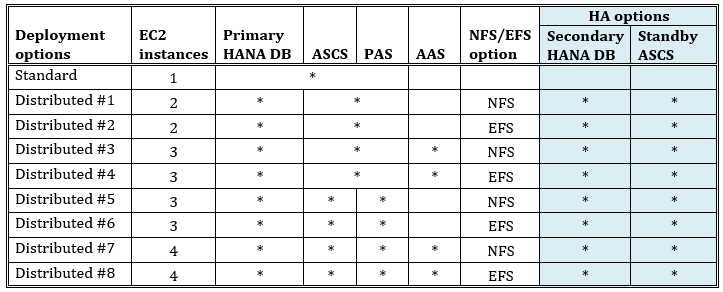AWS for SAP
Now available: SAP S/4HANA Quick Start for rapid deployment on AWS
This post was written by Kuang-Shih Howard Lee, who is an SAP solutions architect at Amazon Web Services (AWS).
In today’s business world, speed is everything. Enterprises must transform their IT assets at an increasing pace to stay ahead while dealing with complex technologies and deployment models. At Amazon Web Services (AWS), we’re working on simplifying and fast-tracking your SAP software deployments to the cloud, to save you time and resources. We’re excited to announce a new AWS Quick Start for SAP S/4HANA that enables businesses to deploy their SAP S/4HANA workloads on the AWS Cloud in less than three hours, compared with a manual deployment that can take days or even weeks to complete.
SAP S/4HANA, the newest generation of the enterprise resource planning (ERP) software package from SAP that supports core enterprise business functions, is optimized for SAP HANA in-memory databases. With the recently released Amazon EC2 High Memory instances, SAP customers now have the ability to scale their SAP HANA database up (up to 12 TB of memory) and out (up to 48 TB of memory) for extremely large S/4HANA deployments. For details, see SAP S/4HANA on AWS on the AWS website.
What is the AWS Quick Start for SAP S/4HANA?
The AWS Quick Start for SAP S/4HANA is a deployment automation tool designed by AWS solution architects that is built on AWS CloudFormation, Python, and shell scripts. The Quick Start follows best practices from AWS, SAP, and Linux vendors to automatically set up an AWS environment and ready-to-run SAP S/4HANA system. (This Quick Start is the latest addition to the set of AWS Quick Starts that automate the deployment of SAP workloads; you might also want to check out the Quick Starts for SAP HANA, SAP Business One, version for SAP HANA, and SAP NetWeaver.)
SAP S/4HANA Quick Start components and deployment options
The Quick Start deploys an SAP S/4HANA system that consists of a number of Amazon Elastic Compute Cloud (Amazon EC2) instances and AWS core infrastructure services into a new or an existing virtual private cloud (VPC) in your AWS account. It offers two main deployment options: a single-scenario standard deployment and a multi-scenario distributed deployment with or without SAP software installed. Additionally, you can choose whether to use Amazon Elastic File System (Amazon EFS) or Network File System (NFS) for your shared file system. You can also choose to deploy a bastion host and Remote Desktop Protocol (RDP) server. You can choose a combination of the following components to launch an SAP S/4HANA environment that meets your requirements.
Primary resources:
- SAP HANA primary database
- SAP S/4HANA ABAP SAP Central Services (ASCS) server
- SAP S/4HANA Primary Application Server (PAS)
Secondary and optional resources:
- SAP HANA secondary database for high availability
- SAP S/4HANA standby ASCS server for high availability
- Optional SAP S/4HANA Additional Application Server (AAS)
- Optional bastion host and RDP instances
To ensure business continuity, the AWS Quick Start for SAP S/4HANA also enables you to create a SAP HANA database with high availability, using SAP HANA System Replication (HSR) across Availability Zones within an AWS Region. In addition, you can set up a standby ASCS server for high availability alongside the SAP HANA database to protect mission-critical SAP workloads from Availability Zone outages.
The Quick Start offers the following standard and distributed deployment options for SAP S/4HANA on AWS.
For more information about these deployment options, see the AWS Quick Start for SAP S/4HANA deployment guide.
The S/4HANA architecture on AWS
The following diagram shows the standard deployment architecture of a typical four-server SAP S/4HANA cluster that hosts the SAP HANA database, ASCS, PAS, and AAS separately in a private subnet within the same Availability Zone, and a bastion host and RDP server in a public subnet.
The following diagram shows the deployment architecture of a typical four-server, high-availability cluster that hosts the primary SAP HANA database, primary ASCS, PAS, and AAS separately in a private subnet in one Availability Zone, and the secondary SAP HANA database and standby ASCS in a private subnet in another Availability Zone. This architecture also includes a bastion host in an Auto Scaling group and an RDP server in the public subnet of the first Availability Zone.
Getting started
To get started with this Quick Start deployment, read through the deployment guide to get a general understanding of the components and deployment options, and then follow the instructions in the guide to launch the Quick Start into your AWS account. Depending on your parameter selections, the Quick Start can run between 1.5 to 2.5 hours to complete the deployment.
The source templates and codes are available to download from GitHub. If you would like to customize this Quick Start to meet your needs, see the AWS Quick Start Contributor’s Guide.
What’s next?
We will continue to enhance the SAP S/4HANA Quick Start to support new operating system versions, SAP S/4HANA software packages, and AWS services and instance types. Let us know if you have any comments or questions—we value your feedback.



